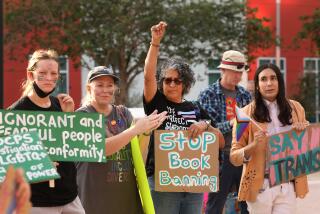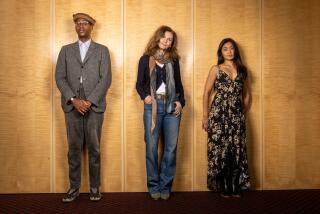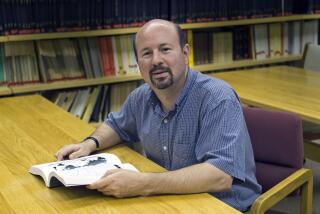Faith, forgery, science -- and the James Ossuary
- Share via
On March 14, a Jerusalem judge acquitted a man accused of forging an inscription on a small stone coffin. The writing, on what’s known as the James Ossuary, reads “James son of Joseph brother of Jesus.” Its promoters claim that it’s the first archaeological evidence of Jesus Christ’s existence and that the box once held the bones of Jesus’ brother James. Its detractors, including most scholars, say the last two words of the inscription are faked, modern additions to a genuinely ancient limestone casket.
The box was first brought to public attention in 2002. Tens of thousands lined up in freezing Canadian weather to see it go on exhibit — with a sly caveat about its authenticity — at the Royal Ontario Museum in January 2003.
The box was seized on by believers as proof of the Bible. But Israeli authorities, who eventually found what appeared to be a forgery workshop in the apartment of the box’s owner, Tel Aviv industrial designer and antiquities collector Oded Golan, called it a fraud. The workshop contained half-made “antiquities,” plans for others and even labeled baggies of silt from different archaeological sites around the Holy Land. The state would later assert that the silt was used to create a paste to coat the objects and fool scholars.
A trial commenced in 2005 against Golan, accused of “the fraud of the century” for creating objects meant to both make money and headlines. In effect, the lengthy trial put science in the dock. Science lost.
Israeli prosecutors were badly underfunded (the nation has its eye on bigger problems than relic forgery), and its investigators never mounted the kind of international, follow-the-money detective work that would have bolstered their case by showing a pattern of criminality involving a number of lesser-known objects that were also part of the case — allegedly ancient lamps and Old Testament-era royal seal impressions that scientists said were fakes.
Prosecutors relied on a parade of archaeologists and other scholars. These men and women were accustomed to addressing respectful colleagues and students. They had no experience defending their conclusions against the highest-paid lawyers in Tel Aviv.
Like scholars and scientists everywhere, their work doesn’t reach a level of precision that can withstand legal cross-examination. They acknowledge doubts. Their opinions don’t always agree in the particulars, even when they arrive at a consensus.
And while the scientists for the state conducted their investigations and testified for free, the defense paid for-hire scientists, who were willing to say the objects at issue were entirely authentic.
In the end, the judge explicitly declined to rule on the authenticity of the objects. “The prosecution failed to prove beyond all reasonable doubt what was stated in the indictment: that the ossuary is a forgery and that Mr. Golan or someone acting on his behalf forged it,” the judge stated. “This is not to say that the inscription on the ossuary is true and authentic and was written 2,000 years ago.... [T]here is nothing in these findings which necessarily proves that the items were authentic.”
But that’s a fine point. Supporters of the ossuary and the other objects that had been discredited by the state’s investigation hailed the acquittal as a legal stamp of approval.
The ossuary’s loudest supporter is American lawyer and publisher Hershel Shanks, whose magazine Biblical Archaeology Review first revealed the object. Shanks has spent the last seven years attacking the “pack of scholars” at the Israel Antiquities Authority and one in particular, an archaeologist named Yuval Goren who found modern silicone glue in the carved ossuary inscription.
Goren, a vice dean of the faculty of humanities at Tel Aviv University, is a mild-mannered expert in materials that ancient craftsmen used to make pottery and art. He testified that a simulated patina had been applied over the inscription, a substance containing powdered calcite and limestone, charcoal and corroded bronze particles and adhered with modern glue he dubbed “James Bond.” That testimony was discredited partly because the test Goren carried out removed the substance from the surface of the box.
Goren’s findings were hardly the only evidence against Golan. Eventually an Israeli police officer tracked down an Egyptian who admitted having worked for Golan, creating objects that were meant to look ancient.
The craftsman told police that he made objects under Golan’s direction “with a hammer and chisel, following the sketch. He [Golan] printed out a sheet from the printer and gave it to me.” Later the officer asked: “But it’s clearly not ancient.” The craftsman responded: “That’s right, it’s new.” But thanks to the vicissitudes of Arab-Israeli relations, the Egyptian couldn’t be forced to testify, so the interview couldn’t be introduced in court.
Despite widespread knowledge of that stunning transcript and the damning workroom evidence reported by police, Golan’s supporters made Goren a whipping boy at the courthouse and in biblical archaeology websites. Because he dared to cast doubt on the ossuary — and therefore on the literal truth of the Bible — his professionalism was trashed and he was variously called a religion-hating atheist, a hater of Israel and a self-hating Jew.
Attacking scientists is increasingly common as religious and ideological zealots flatly reject data that offend their creeds. Recently a pro-mining consortium threatened legal action against academic journals about to publish studies linking mining-related air pollution and lung cancer. Climate scientists whose work indicates that global warming is caused by humans’ burning of fossil fuels now routinely receive hate mail and have had their emails systematically hacked by those who disagree, mostly on faith.
The methods used to discredit the best archaeologists in Israel — by seizing on minor data points or a minority of dissenters who deviate from the consensus — is exactly what happens in the debate about climate science. The non-expert public is then forced to choose which view makes the most sense.
For those who seek to prove that the Bible is literally true, the particulars of science matter little. They want tangible artifacts, and the details be damned. Israel Finkelstein, dean of archaeology at Tel Aviv University (whose work in Solomonic-era archaeology does not fit with Bible stories about Solomon) told me that if the state lost the ossuary case, we should expect a bumper crop of shady Bible-proving finds: “Inscriptions from the time of Solomon, from the time of David, the T-shirt of Moses, the crown of King Solomon, the sandals of Abraham. That’s the future, if there is an acquittal.”
Fighting legitimate science to provide proof for religious faith is a relatively victimless pastime. A few scientists’ reputations get burned and believers get another object for the reliquary.
But when faith trumps reason as the whole world gets hotter, scientists aren’t the only ones paying the price.
Nina Burleigh is the author of “Unholy Business: A True Tale of Faith, Greed and Forgery in the Holy Land.” She is working on an e-book on Islamists and women after the Arab Spring.
More to Read
A cure for the common opinion
Get thought-provoking perspectives with our weekly newsletter.
You may occasionally receive promotional content from the Los Angeles Times.






